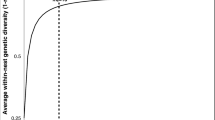Summary
In the Rhytidoponera impressa group, populations of Type A (queenright, monogynous) colonies produce numerous colony-founding queens and have markedly female-biassed sex ratios of investment, the mean proportional investment in females (PF) being 0.824 for thirteen populations of confusa, chalybaea, and purpurea (0.839 for ten confusa populations). (All proportional means are retransformed from the angular transformation.)
By contrast, Type B (worker-reproductive, usually polygynous) colonies reproduce by colony fission and show less female-biassed investment ratios, with mean PF values (12 populations, 2 species) ranging from 0.358 to 0.721, for estimates of colony fission costs ranging from 10% to 50% of the worker force.
The population PF for Type A colonies shows significant positive correlations with the relative frequency (r=0.63, df=11, P<0.025) and density (r=0.70, df=11, P<0.01) of sympatric Type B colonies, indicating that Type A colonies compensate for male bias in the community sex ratio generated by Type B colonies.
In one population (of purpurea) consisting entirely of Type A colonies, the estimated population PF was 0.736. In the absence of evidence for inbreeding or local mate competition, this suggests worker control of the investment ratio.
There is a substantial amount of unexplained intrapopulation variation in colony sex ratios. Colony-level PF values for Type A colonies range from 0.00 to 1.00, and are not significantly correlated with colony size, number of alates, worker size, or weights of alates.
Similar content being viewed by others
References
Alexander RD, Sherman PW (1977) Local mate competition and parental investment in social insects. Science 196:494–500
Benford FA (1978) Fisher's theory of the sex ratio applied to the social Hymenoptera. J Theor Biol 72:701–727
Boomsma JJ, van der Lee GA, van der Have TM (1982) On the production ecology of Lasius niger L. in successive coastal dune valleys. J Anim Ecol 51:975–991
Brian MV (1979) Habitat differences in sexual production by two co-existent ants. J Anim Ecol 48:934–953
Charnov EL (1978) Sex ratio and local resource competition in a prosimian primate. Science 201:163–165
Craig R (1980) Sex investment ratios in social Hymenoptera. Am Nat 116:311–323
Fisher RA (1930) The genetical theory of natural selection. Oxford University Press, Clarendon
Forsyth A (1981) Sex ratio and parental investment in an ant population. Evolution 35:1252–1253
Hamilton WD (1967) Extraordinary sex ratios. Science 156:477–488
Hamilton WD (1972) Altruism and related phenomena, mainly in social insects. Annu Rev Ecol Syst 3:193–232
Macevicz S (1979) Some consequency of Fisher's sex ratio principle for social. Hymenoptera that reproduce by colony fission. Am Nat 113:363–371
Metcalf RA (1980) Sex ratios, parent-offspring conflict, and local competition for mates in the social wasps Polistes metricus and Polistes variatus. Am Nat 116:642–654
Oster G, Eshel I, Cohen D (1977) Worker-queen conflict and the evolution of social insects. Theor Popul Biol 12:49–85
Owen RE, Rodd FH, Plowright RC (1980) Sex ratios in bumble bee colonies: complications due to orphaning? Behav Ecol Sociobiol 7:287–291
Pamilo P (1982) Genetic evolution of sex ratios in eusocial Hymenoptera: allele frequency simulations. Am Nat 119:638–656
Pamilo P, Rosengren R (1983) Sex ratio strategies in Formica ants. Oikos 40:24–35
Trivers RL, Hare H (1976) Haplodiploidy and the evolution of the social insects. Science 191:249–263
Uyenoyama MK, Bengtsson BO (1981) Towards a genetic theory for the evolution of the sex ratio. II. Haplodiploid and diploid models with sibling and parental control of the brood sex ratio and brood size. Theor Popul Biol 20:57–79
Ward PS (1980) Genetic variation and population differentiation in the Rhytidoponera impressa group, a species complex of ponerine ants. Evolution 34:1060–1076
Ward PS (1981a) Ecology and life history of the Rhytidoponera impressa group. I. Habitats, nest sites, and foraging behavior. Psyche 88:89–108
Ward PS (1981b) Ecology and life history of the Rhytidoponera impressa group. II. Colony origin, seasonal cycles, and reproduction. Psyche 88:109–126
Ward PS (1983) Genetic relatedness and colony organization in a species complex of ponerine ants. I. Gentoypic and phenotypic composition of colonies. Behav Ecol Sociobiol 12:285–299
Author information
Authors and Affiliations
Rights and permissions
About this article
Cite this article
Ward, P.S. Genetic relatedness and colony organization in a species complex of ponerine ants. Behav Ecol Sociobiol 12, 301–307 (1983). https://doi.org/10.1007/BF00302897
Received:
Accepted:
Issue Date:
DOI: https://doi.org/10.1007/BF00302897




